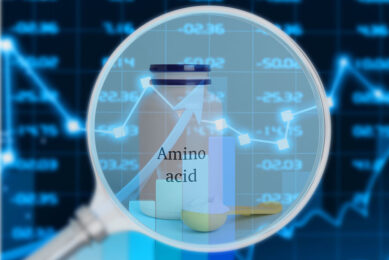Amino acid balancing for better milk protein yield
For many dairy nutritionists and producers, the next step to higher milk protein content is balancing amino acid levels in the herd’s rations. Among dairy nutritionists, this has become a best practice, especially when using updated ration formulation software which simplifies the process.
When the ration’s amino acid levels are matched to the cow’s biological needs, the cow’s nutritional status improves.
To achieve this goal, the ration fed typically includes a rumen-protected, metabolisable methionine.
The most common result is an increase in milk protein, the best known benefit of amino acid balancing, according to Dan Luchini, manager ruminant products technical services at Adisseo.
Other benefits exist, though, he notes, such as increases in both milk volume and milk fat and a decrease in nitrogen excretion.
To quantify the response to amino acid balancing in a single number, the figure for energy corrected milk (ECM) is often used.
Efficient nitrogen use
Balancing amino acids supports more efficient nitrogen so less crude protein (CP) can be fed.
Reducing crude protein helps reduce feed costs and makes room for more high-quality forage while decreasing nitrogen excretion.
In recent research, one group of cows was fed a 16.8% crude protein diet that provided an estimated 2,590 grams of metabolisable protein with a lysine to methionine ratio (Lys: Met) of 3.33.
Another group of cows was fed a 15.7% crude protein diet that delivered 2,450 grams of metabolisable protein for a Lys: Met ratio of 2.98.
The ration with higher crude protein contained 140 more grams of metabolisable protein, yet its amino acid levels were out of balance.
Both rations delivered similar grams of metabolisable lysine. The ration with lower crude protein, however, provided six extra grams of metabolisable methionine from its 40 grams of dry MetaSmart, a rumen-protected methionine.
The cows fed the diet with the lower nitrogen load (15.7% CP) produced 1 kg of milk with better fat and protein percentage.
They had a significant 1.6 kg of extra ECM. They also had lower plasma urea nitrogen (PUN) and milk urea nitrogen (MUN) which confirm better efficiency of nitrogen utilization.
Item | 16.8% Crude Protein | 15.7 % Crude Protein with MetaSmart |
Metabolizable protein, g/d | 2590 | 2450 |
Metabolizable Lysine, g/d | 160 | 161 |
Metabolizable Methionine, g/d | 48 | 54 |
Lys:Met | 3.33 | 2.98 |
Milk, kg/d | 41.2 | 42.1 |
Fat, % | 3.85 | 3.93 |
True Protein, % | 3.05b | 3.19a |
Lactose, % | 4.81 | 4.83 |
Energy Corrected Milk (ECM), kg/d | 39.4b | 41.0a |
Milk Urea Nitrogen (MUN), mg/d | 13.2a | 10.2b |
Plasma Urea Nitrogen (PUN) | 15.7a | 12.2b |
Milk N/N intake (N efficiency, %) | 30.2b | 32.3a |
Join 26,000+ subscribers
Subscribe to our newsletter to stay updated about all the need-to-know content in the feed sector, three times a week. Beheer
Beheer









 WP Admin
WP Admin  Bewerk bericht
Bewerk bericht